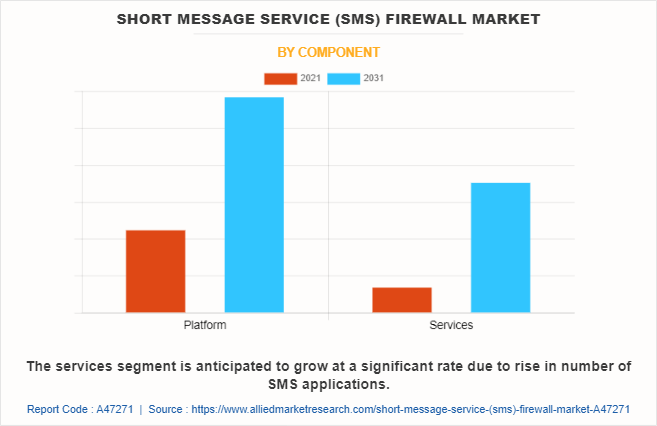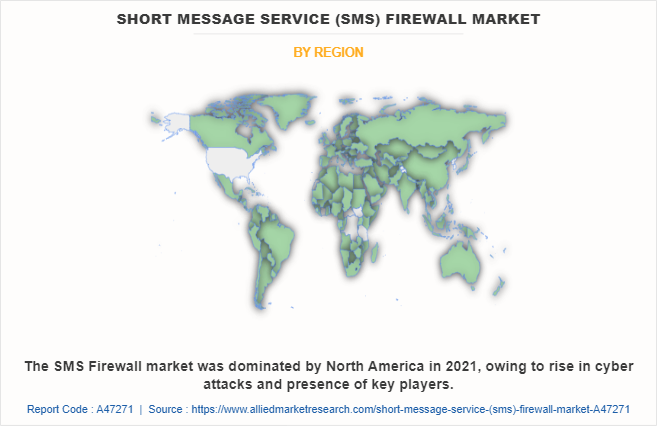Short Message Service (SMS) Firewall Market Insights, 2031
The global short message service (sms) firewall market was valued at $2.5 billion in 2021, and is projected to reach $5.7 billion by 2031, growing at a CAGR of 9.2% from 2022 to 2031.
The rise in the adoption of application-to-person messaging, and the increased privacy and security concerns among users are the major factors driving the short message service (SMS) firewall market growth. In addition, countering SMS illicit practices such as SMS spoofing, SMS phishing, and SMS spamming drives the growth of the short message service (SMS) firewall market size. However, a lack of technological knowledge among users, and the rise in the number of cyberattacks hampering the growth of the short message service (SMS) firewall market. On the contrary, the trend of mobile marketing through SMS, and the demand for next-generation SMS firewalls will provide major lucrative opportunities for the growth of the short message service (SMS) firewall market.

The growing A2P messaging congestion is predicted to fuel the worldwide SMS firewall market's growth. A2P messaging refers to message traffic where a person gets an SMS from an app or a software program instead of another individual, and these communications are triggered depending on certain criteria or situations. Use of such SMS firewalls to commercialize A2P traffic is growing, and it is accomplished by restricting possible grey routes and terminating A2P through legitimate channels, which reduces income leakage. The growing need for SMS firewalls for better user experience is projected to drive their adoption among mobile network providers. All messages flowing through the firewall system are categorized and evaluated to maximize user safety, which delivers a rich user experience, increasing adoption and driving market revenue growth.
Furthermore, major market players are undertaking various strategies to increase the competition and offer enhanced services to their customers. For instance, in July 2021, AdaptiveMobile Security was acquired by Enea, one of the world’s leading suppliers of innovative software for telecommunication and cybersecurity. Enea’s focus areas are cloud-native, 5G-ready products for data management, mobile video traffic optimization, edge virtualization, and traffic intelligence with a strong focus on security. AdaptiveMobile Security delivers software and services for messaging and signaling security in mobile core networks protecting more than 80 mobile network operators, Governments, and regulators. Its products secure mobile networks, their subscribers, and their data from all types of network-borne attacks. The short message service (sms) firewall market is segmented into Component, SMS Type, Deployment Mode, SMS Traffic and End User.
Segment Review
The short message service (SMS) firewall market is segmented on the basis of component, SMS type, deployment mode, SMS traffic, end user, and region. By component, it is segmented into platform and services. On the basis of SMS type, it is divided into A2P messages and P2A messages. Based on deployment mode, it is segregated into on-premise and cloud. By SMS traffic, it is segmented into national SMS traffic and international SMS traffic. By end user, the market is divided into BFSI, IT & telecom, retail and e-commerce, healthcare, media & entertainment, government and public sector, and others. By region, it is analyzed across North America, Europe, Asia-Pacific, and LAMEA.

On the basis of component, the platform segment is the highest growing segment. This is attributed to the rise in adoption of SMS firewall platform for strengthening security of the platform and rise in adoption by end users such as BFSI and IT & telecom sector. However, the services segment is expected to grow at the highest rate during the forecast period, due to its rise in adoption of professional and managed services for SMS firewall.

Region wise, the SMS firewall market was dominated by North America in 2021, and is expected to retain its position during the forecast period, owing to its highly digitized technological sector, which requires a higher degree of network monitoring, fueling the demand for SMS firewall in the region. However, Asia Pacific is expected to witness significant growth during the forecast period, owing to its growing internet penetration and the growing number of cyber threats in the region.
Top Impacting Factors -
The rise in the adoption of application-to-person messaging
The rising adoption of application-to-person messaging drives the growth of the market. Application-to-Person (A2P) messaging, or one-directional messaging from an application to a person where no reply is expected, has gained growth from Mobile Network Operators (MNOs). For instance, in 2020, the COVID-19 pandemic drove significant business growth for A2P and messaging services, with many mobile carriers experiencing exponential growth.
Furthermore, various enterprises, within the finance, retail, travel, and healthcare arenas, are using A2P to communicate directly with their customers to send notifications, PIN codes, critical alerts, and two-factor authentication messages. From the consumer side, they received an A2P with online banking service, made an online purchase, ordered takeout, or more specific to the pandemic, received messages directing them to websites for information about COVID-19, including testing and vaccine locations. Hence, the rising adoption of A2P messaging increases the concerns for security and privacy among users. Thus, this has resulted in a rise in demand for an SMS firewall. Therefore, these factors propel the growth of the short message service firewall industry.
Countering SMS illicit practices such as SMS spoofing, SMS phishing, and SMS spamming
The increasing danger and prevalence of phishing, or smishing (SMS phishing) is a larger concern for individuals and organizations moving forward. Consumers typically express greater trust in an SMS than an email, however, with the increase in smishing, people lose trust, with concerns about fraudulent links and A2P avoidance.
In addition, the rising stringent government regulations to protect subscriber information and rights by implementing security standards, such as IR 70 and IR 71, are expected to enhance the SMS firewall market growth. Moreover, increasing gray route traffic is spawning illegitimate traffic including viruses and frauds. Implementation of regulations to perform periodic checks and identify & block grey routes are expected to flourish the SMS firewall industry.
The increasing privacy and security concerns
Increasing messaging attacks, such as faking, flooding, spamming, and spoofing have increased privacy and security concerns among users. Thus, these are expected to boost the demand for this technology. With the increasing data traffic, network operators have received a large volume of spam messages that have blocked the network bandwidth and negatively impacted the service quality. Furthermore, SMS firewall market solutions help MNOs to overcome this problem, reduce operational costs, enhance customer experience, and regain revenues that declined due to the emergence of over-the-top players such as Snapchat, Viber, and WhatsApp.
In addition, an increase in the use of application-to-person (A2P) SMS by enterprises primarily for CRM and marketing campaigns is expected to escalate the SMS firewall market size. With the advent of the enterprise A2P industry, the value chain between enterprises and their subscribers has become increasingly complex and difficult to manage. These solutions simplify the value chain and ensure that subscribers of any SMS service are not subjected to spam messages, thus improving customer retention. Therefore, these are the major factors driving the growth of the short message service firewall market share.
Market Landscape & Trends
The process of sending SMS from an application to a mobile user is known as A2P SMS, also known as enterprise messaging. Organizations use A2P to reach out to their authentic consumers via SMSs. A2P is taken growth in the BFSI sector since the banking sector is using A2P SMS to send relevant banking notifications and information directly to the user's phone, which has improved efficiency and communication.
For Instance, Infobip provides the A2P SMS type to provide services such as authentication SMS, notification updates, passcode reset links, OTPs, and others. They reach out to customers with more reliable messaging solutions. Furthermore, for more than 15 years, financial institutions have been using A2P SMS by delivering automated SMS notifications such as balance statements, payment reminders, withdrawal notifications, and others to their client's mobile phones to keep them updated. Therefore, these are the major key trends for driving the growth of the short message service (SMS) firewall market.
In addition, the growing adoption of application-to-person SMS, tighter government regulations, and increasing privacy and security concerns may assist the market to embrace solid growth prospects. Companies in the market are estimated to use various business tactics including business expansions, partnerships, and acquisitions to protect a prominent hold in the near future.
For instance, in March 2020, Sinch, a global leader in cloud communications and software for mobile operators, formed a partnership with Ericsson to support its worldwide 5G rollout with messaging technology. Sinch’s SMSF (SMS Function), a cloud-native 3GPP-specified messaging product, was incorporated into the Ericsson core network offering. In 5G, SMS continues to support person-to-person (P2P) and application-to-person (A2P) messaging and further be extended to support new use cases, including the Internet of Things (IoT). Therefore, these are the trends attributed to increasing the growth of the short message service firewall market size.
Key Benefits for Stakeholders
- This report provides a quantitative analysis of the market segments, current trends, estimations, and dynamics of the short message service firewall market forecast from 2021 to 2031 to identify the prevailing market opportunities.
- The market research is offered along with information related to key drivers, restraints, and opportunities of short message service firewall market growth.
- Porter's five forces analysis highlights the potency of buyers and suppliers to enable stakeholders to make profit-oriented business decisions and strengthen their supplier-buyer network.
- In-depth analysis of the short message service (SMS) firewall market segmentation assists in determining the prevailing short message service firewall market analysis.
- Major countries in each region are mapped according to their revenue contribution to the global market.
- Market player positioning facilitates benchmarking and provides a clear understanding of the present position of the market players.
- The report includes an analysis of the regional as well as short message service firewall market trends, key players, market segments, application areas, and market growth strategies.
Short Message Service (SMS) Firewall Market Report Highlights
| Aspects | Details |
| Market Size By 2031 | USD 5.7 billion |
| Growth Rate | CAGR of 9.2% |
| Forecast period | 2021 - 2031 |
| Report Pages | 26 |
| By End User |
|
| By Component |
|
| By SMS Type |
|
| By Deployment Mode |
|
| By SMS Traffic |
|
| By Region |
|
| Key Market Players | TATA Communications, Proofpoint, Sinch, Mobileum, AdaptiveMobile Security, Cellusys, Infobip Ltd., BICS, Comviva, Monty Mobile |
Analyst Review
SMS Firewall defends mobile networks against all SMS-based messaging attacks and provides full protection and control over all messaging on the network. All messages are routed through the firewall, analysed, and classified. This means even those to outbound roamers are screened. Furthermore, spam events can be automatically detected and blocked. After a fraudulent or suspicious A2P SMS has been blocked, the message sender can be informed that their message was delivered, when in fact it has been removed from the network. Alternatively, grey or suspicious A2P SMS messages can be modified to include a warning to the recipient. The significant adoption of alternative approaches in the coming years due to factors such as an increased emphasis on preventing revenue loss due to grey routes is expected to drive the growth of the short message service (SMS) firewall market.
In addition, market players are adopting strategies for enhancing their services in the market and improving customer satisfaction. For instance, in May 2021, Infobip?Group,?a global cloud communications platform company for businesses,?and a leader in telecom solutions has acquired the number?one?SMS firewall service provider?Anam which offers solutions to more than 80 MNOS with more than 606 million customers across the world. This strategic?acquisition?strengthens?Infobip’s?position as the first choice for mobile network operators through enhanced product and service offerings.?Their combined product?portfolio for MNOs represents an exceptional proposition to mobile operators that also vastly benefit subscribers, and includes best-in-class SMS Firewall, SMS Hubs, SMSC,?CPaaS, RCS, and Authentication & Verification.
The global short message service (sms) firewall market was valued at $2,451.73 million in 2021, and is projected to reach $5,676.44 million by 2031, registering a CAGR of 9.2% from 2022 to 2031.
The rise in the adoption of application-to-person messaging, and the increased privacy and security concerns among users are the major factors driving the short message service (SMS) firewall market growth.
North America is the largest regional market for SMS Firewall market.
AdaptiveMobile Security, BICS, Cellusys, Comviva, Infobip Ltd., Mobileum, Monty Mobile, Proofpoint, Sinch, and TATA Communications
The key growth strategies include product portfolio expansion, acquisition, partnership, merger, and collaboration.
Loading Table Of Content...
Loading Research Methodology...


